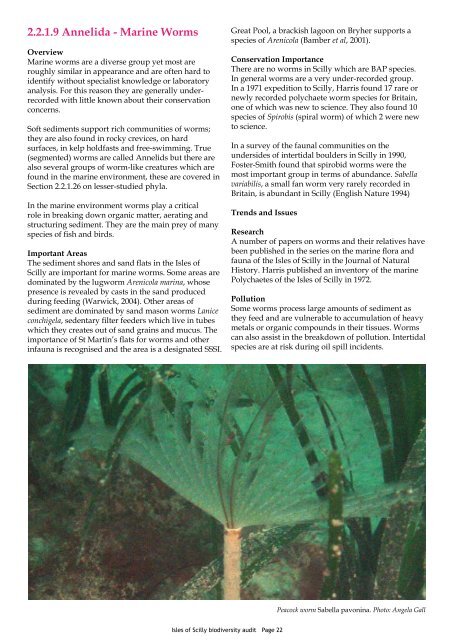The Isles of Scilly Biodiversity Audit 2008 - Cornwall Wildlife Trust
The Isles of Scilly Biodiversity Audit 2008 - Cornwall Wildlife Trust
The Isles of Scilly Biodiversity Audit 2008 - Cornwall Wildlife Trust
You also want an ePaper? Increase the reach of your titles
YUMPU automatically turns print PDFs into web optimized ePapers that Google loves.
2.2.1.9 Annelida - Marine WormsOverviewMarine worms are a diverse group yet most areroughly similar in appearance and are <strong>of</strong>ten hard toidentify without specialist knowledge or laboratoryanalysis. For this reason they are generally underrecordedwith little known about their conservationconcerns.S<strong>of</strong>t sediments support rich communities <strong>of</strong> worms;they are also found in rocky crevices, on hardsurfaces, in kelp holdfasts and free-swimming. True(segmented) worms are called Annelids but there arealso several groups <strong>of</strong> worm-like creatures which arefound in the marine environment, these are covered inSection 2.2.1.26 on lesser-studied phyla.In the marine environment worms play a criticalrole in breaking down organic matter, aerating andstructuring sediment. <strong>The</strong>y are the main prey <strong>of</strong> manyspecies <strong>of</strong> fish and birds.Important Areas<strong>The</strong> sediment shores and sand flats in the <strong>Isles</strong> <strong>of</strong><strong>Scilly</strong> are important for marine worms. Some areas aredominated by the lugworm Arenicola marina, whosepresence is revealed by casts in the sand producedduring feeding (Warwick, 2004). Other areas <strong>of</strong>sediment are dominated by sand mason worms Laniceconchigela, sedentary filter feeders which live in tubeswhich they creates out <strong>of</strong> sand grains and mucus. <strong>The</strong>importance <strong>of</strong> St Martin’s flats for worms and otherinfauna is recognised and the area is a designated SSSI.Great Pool, a brackish lagoon on Bryher supports aspecies <strong>of</strong> Arenicola (Bamber et al, 2001).Conservation Importance<strong>The</strong>re are no worms in <strong>Scilly</strong> which are BAP species.In general worms are a very under-recorded group.In a 1971 expedition to <strong>Scilly</strong>, Harris found 17 rare ornewly recorded polychaete worm species for Britain,one <strong>of</strong> which was new to science. <strong>The</strong>y also found 10species <strong>of</strong> Spirobis (spiral worm) <strong>of</strong> which 2 were newto science.In a survey <strong>of</strong> the faunal communities on theundersides <strong>of</strong> intertidal boulders in <strong>Scilly</strong> in 1990,Foster-Smith found that spirobid worms were themost important group in terms <strong>of</strong> abundance. Sabellavariabilis, a small fan worm very rarely recorded inBritain, is abundant in <strong>Scilly</strong> (English Nature 1994)Trends and IssuesResearchA number <strong>of</strong> papers on worms and their relatives havebeen published in the series on the marine flora andfauna <strong>of</strong> the <strong>Isles</strong> <strong>of</strong> <strong>Scilly</strong> in the Journal <strong>of</strong> NaturalHistory. Harris published an inventory <strong>of</strong> the marinePolychaetes <strong>of</strong> the <strong>Isles</strong> <strong>of</strong> <strong>Scilly</strong> in 1972.PollutionSome worms process large amounts <strong>of</strong> sediment asthey feed and are vulnerable to accumulation <strong>of</strong> heavymetals or organic compounds in their tissues. Wormscan also assist in the breakdown <strong>of</strong> pollution. Intertidalspecies are at risk during oil spill incidents.Peacock worm Sabella pavonina. Photo: Angela Gall<strong>Isles</strong> <strong>of</strong> <strong>Scilly</strong> biodiversity audit Page 22
















